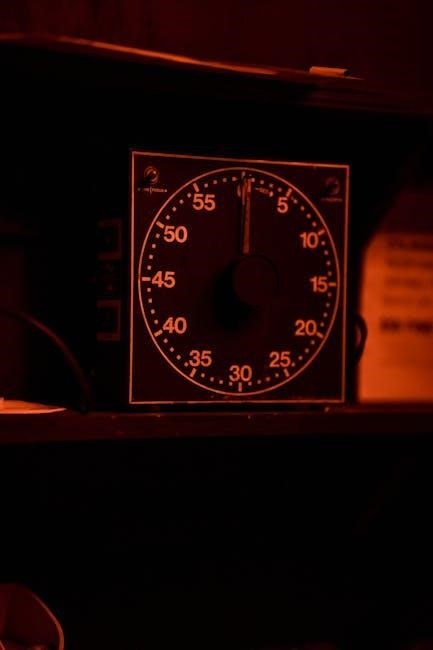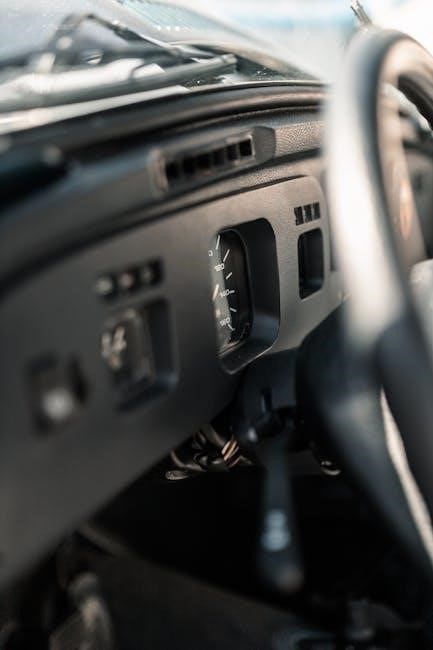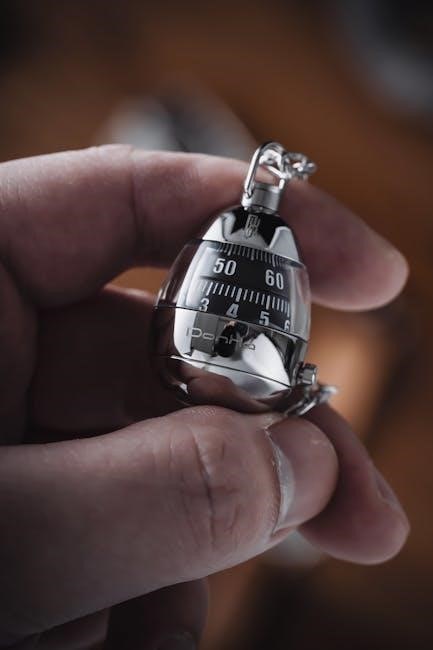DEWENWILS Timer Manual: A Comprehensive Guide
Welcome to your comprehensive guide to DEWENWILS timers! This resource will help you navigate the various DEWENWILS timer models, including outdoor digital timers, sprinkler timers, and indoor timers. Whether you’re looking for setup instructions, troubleshooting tips, or downloadable manuals, you’ll find valuable information to maximize your timer’s functionality and ensure optimal performance.
DEWENWILS timers offer a practical solution for automating various tasks around your home and garden. From controlling outdoor lighting to managing sprinkler systems, these timers provide convenience and energy savings. Known for their user-friendly design and durable construction, DEWENWILS timers cater to a wide range of needs.

These timers are designed to simplify your life by allowing you to set schedules for electrical devices. Whether you need to turn lights on and off at specific times, control your pool pump, or manage your garden irrigation, DEWENWILS timers offer flexible programming options. Many models feature automatic, rain delay, and manual modes, providing complete control over your devices.
DEWENWILS timers are built to withstand the elements, making them suitable for both indoor and outdoor use. The weather-resistant housing ensures long-lasting durability, while the intuitive interface makes programming easy. With features like power back-up and clear instructions, DEWENWILS timers are designed for ease of use and reliability. By automating your devices, you can save energy, reduce your workload, and enjoy a more efficient home.
Types of DEWENWILS Timers
DEWENWILS offers a diverse range of timers designed to meet various needs, from indoor lighting control to comprehensive outdoor irrigation systems. Understanding the different types of timers available is crucial for selecting the right model for your specific application. The product line includes indoor timers, outdoor digital timers, sprinkler timers, and specialty timers like pool pump timers.
Indoor timers are ideal for controlling lamps, holiday decorations, and small appliances. These timers often feature simple programming and can help save energy by automatically turning devices off when not needed. Outdoor digital timers are designed to withstand the elements and are perfect for controlling landscape lighting, security systems, and other outdoor devices. Many models offer multiple on/off settings and rain delay functions.
Sprinkler timers are specifically designed for managing irrigation systems. These timers allow you to set watering schedules, control multiple zones, and adjust watering durations. They often include features like rain delay and manual override for added convenience. Pool pump timers are designed to automate the operation of pool pumps, helping to save energy and maintain water quality. Each type of DEWENWILS timer is engineered for reliability and ease of use, ensuring efficient and effective automation of your devices.

Understanding the DEWENWILS Timer Manual
The DEWENWILS timer manual is your primary resource for effectively using and maintaining your timer. It provides detailed instructions, safety guidelines, and troubleshooting tips specific to your timer model. Familiarizing yourself with the manual is essential for optimal performance and longevity of your device. The manual typically includes sections on initial setup, programming, troubleshooting, and maintenance.
The initial setup section guides you through the process of preparing your timer for use, including charging the internal battery if applicable. The programming section explains how to set the current time, create automatic schedules, and utilize special features like rain delay and manual override. This section often includes step-by-step instructions and diagrams to ensure clarity.
The troubleshooting section addresses common issues you may encounter while using the timer, such as programming errors or malfunctions. It provides potential solutions and guidance on how to resolve these issues. The maintenance section outlines recommended cleaning procedures and other maintenance tasks to keep your timer in good working condition. Always refer to your specific DEWENWILS timer manual for accurate and model-specific information.
Initial Setup and Charging
Before using your DEWENWILS timer, initial setup and charging are crucial steps. Most DEWENWILS timers have an internal battery that needs to be charged before programming. Refer to your timer’s manual for specific charging instructions, as the process may vary depending on the model. Typically, you’ll need to plug the timer into a power outlet for a specified period, often around 30 minutes, to ensure the battery is sufficiently charged.
During charging, the screen should display a charging indicator. Once the battery is adequately charged, the screen will typically show the default time or a ready-to-program message. It’s important to note that some timers may require a longer initial charging time for optimal performance.
Once the timer is charged, proceed with setting the current time and date. This is a fundamental step for accurate scheduling. The manual will provide detailed instructions on navigating the timer’s interface to set these parameters. Ensure you follow the instructions carefully to avoid any errors. Proper initial setup and charging will ensure your timer functions correctly and maintains accurate timekeeping.
Setting the Current Time

Setting the current time on your DEWENWILS timer is a fundamental step to ensure accurate scheduling of your devices or irrigation systems. The method for setting the time may vary slightly depending on the specific model, but generally involves using the timer’s buttons or dial to input the correct hour, minute, and day of the week.
Consult your DEWENWILS timer manual for precise instructions tailored to your model. Often, there is a “CLOCK” button or a similar function that you’ll need to press and hold to enter time setting mode. You can then use the “+” and “-” buttons to adjust the values. Some models might also have a dial that you turn clockwise or counterclockwise.
Pay close attention to the AM/PM setting if your timer uses a 12-hour clock format. Confirm that you’ve selected the correct AM or PM designation to avoid your timer turning on or off at the wrong times. Once you’ve set the correct time, press the “CLOCK” button again to save the settings. Verify the display to ensure the time is accurate. Accurate time setting is essential for reliable timer operation.
Programming Automatic Schedules

Programming automatic schedules is where your DEWENWILS timer truly shines, allowing you to automate tasks like watering your garden or controlling lights. To begin, consult your specific DEWENWILS timer manual for model-specific instructions. Generally, you’ll use the “PROG” button to enter programming mode. Many timers allow for multiple on/off settings per day, offering flexibility.
Once in programming mode, you’ll typically set the “ON” time, followed by the “OFF” time. Some timers allow you to select specific days of the week for the schedule to run, while others offer options like “every day,” “weekdays,” or “weekends.” Use the “+” and “-” buttons or a dial to set the desired times and days. Ensure accuracy to avoid unintended activations.
If your timer supports multiple programs, repeat the process for each schedule you need; After completing your settings, save your configurations by pressing the “CLOCK” button or a similar confirmation button, as indicated in your manual. Double-check your programmed schedules to confirm they are correct. Regular review of your schedules is important, especially after power outages.
Using Rain Delay Mode

The rain delay mode is a valuable feature on many DEWENWILS timers, helping you conserve water and prevent over-watering your plants during rainy periods. When rain is expected or has already occurred, activating the rain delay mode temporarily suspends your programmed watering schedules. This prevents your sprinkler system from running unnecessarily, promoting water conservation and saving you money.

To activate rain delay, locate the “Rain Delay” button on your timer. Pressing this button typically allows you to select a delay period, often in increments of 24, 48, or 72 hours. Refer to your DEWENWILS timer manual for specific instructions and available delay options. The timer will then pause its automatic watering schedules for the specified duration.
During the rain delay period, the timer display will usually indicate that rain delay is active and show the remaining time. Once the delay period expires, your timer will automatically resume its programmed watering schedules. If the rain persists beyond the set delay, you can easily extend the delay period. Remember to deactivate rain delay if conditions change unexpectedly and watering is needed.
Manual Override Function
The manual override function on your DEWENWILS timer offers immediate control over your watering system, allowing you to bypass programmed schedules temporarily. This feature is particularly useful when you need to water outside of the set schedule, such as when planting new vegetation, testing your irrigation system, or addressing specific areas that require extra attention.
To activate manual override, locate the “Manual” button or dial on your timer. Depending on the model, pressing the button may initiate an immediate watering cycle for a pre-set duration, or it may allow you to customize the watering time. If a dial is present, turning it to the “Manual” setting will usually activate the function.
Consult your DEWENWILS timer manual for specific instructions. Some timers may allow you to select which zone or zones to water during the manual override. The display will typically show the active zone and the remaining watering time.
Once the manual watering cycle is complete, the timer will automatically revert to its programmed schedule. Remember to deactivate manual mode if it doesn’t automatically turn off, to prevent unintended watering.

Troubleshooting Common Issues
Encountering issues with your DEWENWILS timer can be frustrating, but many common problems have straightforward solutions. One frequent concern is the timer not powering on. First, ensure the timer is properly plugged into a functioning outlet, and if battery-operated, check and replace the batteries if necessary. Allow the timer to charge for at least 30 minutes.
If the timer is powering on but not following the programmed schedule, double-check that the current time and date are set correctly, since this affects schedule activation. Also, verify that the timer is in “Auto” mode and not in “Rain Delay” or “Manual” mode.
Another issue is the timer skipping watering cycles. Check the rain sensor, as it might be triggered even if there’s no rain. Adjust the sensor’s sensitivity or temporarily disable it to test if it’s the cause.
If a specific zone isn’t watering, inspect the valve connected to that zone for any blockages or malfunctions. Ensure the valve is receiving power and is functioning correctly. If problems persist, consult your DEWENWILS timer manual for detailed troubleshooting steps specific to your model.
Maintenance and Care
Proper maintenance and care are essential to prolong the life and ensure the reliable operation of your DEWENWILS timer. Regularly inspect the timer for any signs of physical damage, such as cracks, loose connections, or water intrusion, especially for outdoor models. Clean the timer’s housing with a soft, damp cloth to remove dirt and debris. Avoid using harsh chemicals or abrasive cleaners, as they can damage the timer’s surface.
For timers with battery backups, periodically check the battery’s condition and replace it as needed, following the instructions in your DEWENWILS timer manual. During periods of inactivity, such as winter, it’s advisable to disconnect the timer from the power source and remove the batteries to prevent corrosion.
If you live in an area with hard water, inspect the sprinkler valves connected to the timer for mineral buildup and clean them regularly to ensure proper water flow. Store your DEWENWILS timer in a cool, dry place when not in use to prevent damage from extreme temperatures or humidity. By following these maintenance tips, you can keep your timer functioning optimally for years to come.

Where to Download DEWENWILS Timer Manuals

Accessing the correct DEWENWILS timer manual is crucial for proper setup, programming, and troubleshooting. Fortunately, DEWENWILS provides several avenues for downloading their timer manuals. The primary source is the official DEWENWILS website. Navigate to the “Support” or “Downloads” section, where you can typically find a comprehensive library of manuals categorized by product type, including indoor timers, outdoor timers, sprinkler timers, and more.
Alternatively, you can often find DEWENWILS timer manuals on online retailer websites like Amazon or Home Depot, particularly on the product pages for specific timer models. Look for a “Downloads” or “Product Information” section on the page.
Another useful resource is ItsManual.com, which collects various owner’s manuals from around the web. You can search for your specific DEWENWILS timer model on their site to see if they have a downloadable manual available. Remember to have your timer’s model number handy when searching for the correct manual to ensure compatibility and accuracy.

No Responses